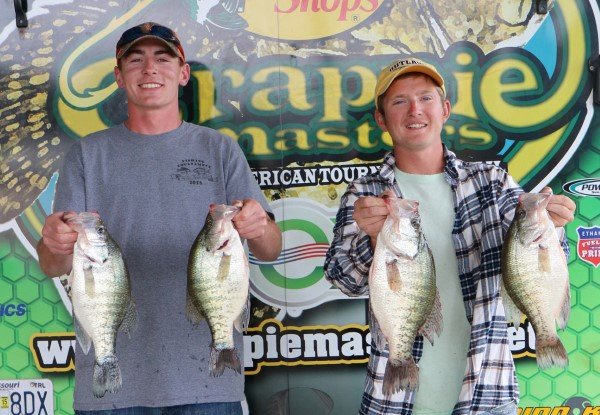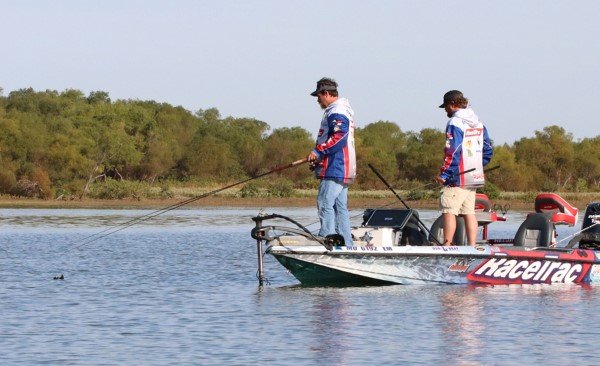by Tim Huffman

Twenty one years of age doesn’t add up decades of fishing experience. However, many hours on the water this year, working to learn patterns and being in the right place at the right time gave two young fishermen what they needed to win.
Mathew Rogers and Baylor Mead stepped into the spotlight as they accepted the Crappie Masters Championship trophies September 29th. The team had a two-day total of 14 fish weighing 21.19 pounds, edging second place by 0.29 pounds.
Unlike many tournaments, all the top teams fished similar structure with a similar style. They were scattered around in different places but the majority of fish were caught from four to ten feet deep with baits near bottom. The following are some specifics of their setup and catches.

First Place, at 20.19 pounds, was Rogers and Mead who didn’t stray too far from the launch ramp although they fished five different spots. “I never understood the fish very well, but after coming back from an illness about a year ago, I started guiding part time,” says Rogers. “That made a huge difference my learning. So we both put time in at Truman, fished some local tournaments and also fished to qualify for this championship. I’ve learned more about the fish and I can read a map to know where I should find them under different conditions, but I still have a lot to learn. We make a lot of mistakes but sometimes make good decisions, too.”
Mead says the biggest difference for them was finding a few spots with big fish. “We went where we knew the big fish had been and worked on those spots. We ran around less than normal, although when things weren’t going well on the morning of day two, we did get to hopping around some before settling down on our top spot.”
The team used Outlaw Rods, 8- and 10-pound Power Pro line, 2-inch jigs made at home by Rogers and a 1/16-ounce head. “There are many similar jigs like the one I’m pouring myself but I can get unique colors that I believe can help because it’s something they don’t see every day.”
The team single-pole fished but used a pole in each hand. It was more work in the thick cover, but they liked the benefits. First, having four baits in the water compared to two meant more fish. And two, it allowed them to fish a thick brushpile or bed much quicker so they could fish more cover.
The team was fishing a flat that had no deep water nearby, but the team believed the fish were travelling across the flat. Fish would slowly replenish allowing them to hit good cover several times.
An important part of their fishing was to stick with places with big fish. The big ones would only bite periodically in a spot. For example, their top spot was terrible the second morning, but after trying other places, they came back to it the last hour of the day and won the tournament there.
The team fished exposed wood but also spent a lot of time fishing submerged cover. Mead says, “We were fishing a lot of underwater cover other fishermen wasn’t touching. That’s uncommon at Truman where so many places are fished by several boats during the day. We fished a variety of trees and didn’t stick to just one thing.”
“As far as winning,” says Rogers, “timing is everything. At the last minute on the water the opening morning we turned a different way than where we had headed. That was a critical move because the spot we held off fishing produced the biggest fish of the tournament later when we went there. If we had gone there first, it’s likely we wouldn’t have been there when the big ones were biting. Right place at the right time. You have to know they are there but luck is involved in having a bait in front of a fish at the right time. There was another spot we knew had big fish, went to it four times on day two but the big ones never hit. Timing is everything.”
Specific cover? They said 80 percent of their fish came from brush and debris, a lot of stuff people have put into the lake but some of it’s natural. “I run Garmin Panoptics. Everyone who uses it knows about how good it is. It gives me the opportunity to position my boat correctly on a tree I can’t visibly see. I can run my jig right beside the tree.”
Big flats in the Grand arm, visible and submerged trees, with a lot of their fish coming from nine feet of water with the bait just off bottom…it’s Advanced Seasonal Structure…and it’s a winner.

Second Place, at 20.90 pounds, was Mark and Aaron Engelhart. The team had spent a lot of time this year working to learn big fish spots and patterns. The work and extra time paid off giving them the runner-up spot.
The team fished the Grand arm in seven to eight feet of water. Their structure was mainly stumps because the beds they had placed produced only small crappie.
“Big fish were relating to stumps,” says Mark. “The one area where we had our best weight was only about 100 by 200 with about 15 stumps. That’s where they were in practice and in the tournament.”
The team says good crappie bit in flurries, with different spots being good at different times. Practice was all about learning the timing for the different spots. One factor that changed everything was clouds. On both days, sun was critical to get the big fish bites.
Their equipment included Jenko and BnM Poles, Gamma and P-Line, Pro Bilt jig heads with Bobby Garland 2-inch plastic in Junebug, and Strike King Thunder jig.
Presentations were much faster than other teams who would have to leave baits in for up to a minute or more to get a bite. When action was good, this team dropped down and if no bite occurred within five seconds, they moved the bait to another stump.
Aaron says, “We had to be in the right spot at the right time, but we had a game plan and stuck to it. We knew where we needed to be when the big bite happened. The plan worked out for us. I wish we had won, but I would take second in this tournament any time and be happy.”
Third Place (tie), at 20.27 pounds, was the team of Shannon and Kyler Beckmann. The team’s structure was a dozen key stumps found during the week when practicing. The best bite was in nine to ten feet of water fishing right on bottom. They believed the critical factor was fishing right next to the channel. They fished through the stumps, then come back through them again and again.
“What we learned in practice and even more during the tournament,” says Shannon, “was to also down, very slow. Drop in until you can stand it any more. Maybe after a minute or more they would hit it. It was old-school type fishing. We tipped our jigs with minnows, went through 11 dozen minnows today, and that’s a lot for jig fishing. We caught over a 100 keepers today.”
Their equipment included Kevin Rogers signature Jenko 10-foot and HyperSense Jenko 10-foot, 15-pound braid and 1/16 Crappie Monster jigs. They soaked jig bodies in JB’s Sauce believing that made a big difference in the number of bites.
“Fishing the right cove was important,” says Kyler, “but the first day we moved slow but not slow enough. That probably made the difference but we’ve had a great tournament and it’s been great this year fishing with my dad.”
Final Notes
The top teams at the Crappie Masters Championship were jigging. Some used one pole while others used a pole in each hand. Jigging allowed baits to be put into and out of dense cover, limbs and beds.
All teams said electronics were key for seeing invisible wood, both natural and placed, and finding the crappie. Garmin Panoptics and Humminbird 360 units appeared to dominate.
Fish were on bottom. Most teams drop the bait to the bottom and lifted it a few inches off bottom. That presentation worked whether in four feet of water or ten feet.
Big fish didn’t bite all day in a given area. Being in the right spot at the right time was critical.
Hedge trees, cedars, stumps and manmade covers are all important structures, along with depths and contours. At Truman, stumps were the best producers with both visible and submerged being important.
Fishermen differed on the best jig. A 1/16, 1/8 and 1/4 ounce were the standard, with 1/4-being very popular because it would get down quickly and give the best sensitivity to bites. However, first place, and several other teams, preferred a 1/16-ounce, saying they got more bites with fewer short strikes. It was easier for the fish to suck it in.
The most popular color was black-chartreuse, especially the Bobby Garland Lights Out.
All fishermen I spoke with used scent and most tipped with minnows. But results varied with each fisherman.
There are two popular theories on rods. One is a stiff rod like a Kevin Rogers signature Jenko or a Huckabee jigging pole, use braided line and swing the fish into the boat. About 95% of the bites are felt. The other theory is to use a light-action, sensitive tip rod, like a BnM BGJP, so more bites are seen at the tip, the fish doesn’t immediately feel the pole, and the limber pole provides a good drag and shock absorber. Big crappie must be netted. Pole choice is a matter of personal preference.
See our tournament results section for complete results. Visit Crappie Masters at www.crappiemasters.net.


